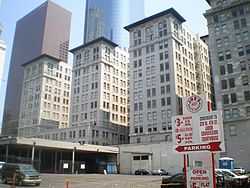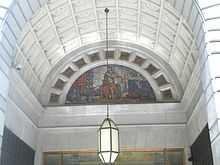Subway Terminal Building
|
Subway Terminal Building | |
 | |
|
Subway Terminal Building, 2008 | |
| Location |
417, 415, 425 S. Hill St., 416, 420 424 S. Olive St Los Angeles, California |
|---|---|
| Architectural style | Italian Renaissance Revival |
| NRHP Reference # | 06000657 |
| LAHCM # | 177 |
| Significant dates | |
| Added to NRHP | August 2, 2006 |
| Designated LAHCM | July 27, 1977 |
Coordinates: 34°03′00″N 118°15′03″W / 34.0498689°N 118.2509694°W
The Subway Terminal Building, now Metro 417, is an Italian Renaissance Revival building in Downtown Los Angeles at 417 South Hill Street. It was designed by architects Schultze and Weaver and was built in 1925. It was the downtown terminus for the "Hollywood Subway" branch of the Pacific Electric Railway Interurban rail line. Currently it is a luxury apartment building. It is near Pershing Square. When the LACMTA Red Line, the replacement for the Hollywood Subway, was built, the Pershing Square station was located nearby.
History

As street traffic increased in downtown Los Angeles, the Pacific Electric Railway undertook its most ambitious project, a dedicated right of way into downtown through a subway - the existing terminal in the Pacific Electric Building at Sixth and Main was reached by shared street running. Responding to the traffic congestion that clogged the streets, the California Railroad Commission in 1922 issued Order No. 9928, which called for the Pacific Electric to construct a subway to bypass downtown's busy streets.[1] Plans for the "Hollywood Subway," as the project came to be known, were drafted as early as February 1924, and ground was broken in May of the same year.[1][2]
The Subway Terminal Building was built to conform to the 150 foot height limit imposed on all downtown construction. The other end of the subway line emerged at the surface at the Belmont Tunnel / Toluca Substation and Yard.
After 18 months of construction and $1.25 million in expenditures, the Subway officially opened to the public on December 1, 1925,[1] between the intersection of Beverly and Glendale Blvds in Westlake, and the Subway Terminal Building..
The early years of the Subway were widely met with success, as it emerged as one of Los Angeles's most popular modes of public transit throughout the 1920s and 1930s. Ridership hit an all-time high during the World War II-era; in 1944 – considered to have been the Subway's peak – trains carried an estimated 65,000 passengers through the tunnel each day.[3]
End of rail traffic
The unprecedented growth which characterized the Los Angeles region in the postwar years ultimately led to the closure of the Subway in the 1950s. Increasing dependence on the automobile as well as the emergence of a complex network of freeways throughout Southern California drastically reduced ridership, forcing Pacific Electric to close the Subway in 1955. The last train to carry passengers – carrying a banner reading "To Oblivion" – traversed the tunnel on the morning of June 19, 1955.[3][4] Shortly thereafter, Pacific Electric removed the tracks and trains from the tunnel and closed the station within the Subway Terminal Building.
Office building
The building served as an office building for many years. The tunnel remained intact until December 1967, when the section from Flower Street to just west of Figueroa Street was filled in.[3]
When the LACMTA Red Line, the replacement for the Hollywood Subway, was built, the Pershing Square station was located nearby.
Renovation to Metro 417
In 2007, the Subway Terminal Building, historic cultural monument #177, has been renovated as "Metro 417", a luxury apartment building owned by Forest City and built by Swinerton Builders. Concerns were raised for the historic Florentine exterior when a 76-story skyscraper, Park Fifth, was initially proposed on the former site of the Philharmonic Auditorium behind the building. In 2014, the new owner, San Francisco real estate investment firm MacFarlane Partners, announced that the Park Fifth development was going ahead with 650 units in a high-rise apartment building. An outdoor paseo would be built between the new complex and the Metro 417 apartments with tables, chairs, and lighting.[5]
See also
- Belmont Tunnel / Toluca Substation and Yard
- Pacific Electric Building
- Pacific Electric Railway
Further reading
- Crump, Spencer (1977). Ride the big red cars: How trolleys helped build southern California. Trans-Anglo Books. ISBN 0-87046-047-1.
Main entry
The floor tile in the entryway reads "SVBWAY TERMINAL" in the pre-Middle Ages Latin alphabet.
References
- ↑ 1.0 1.1 1.2 Electric Railway Historical Association of Southern California
- ↑ "Tunnel Digging Is Begun in Los Angeles: The Hollywood-Glendale-San Fernando Valley tunnel will eliminate 1,000 daily car movements from streets in the congested district. An expenditure of approximately $3,500,000 is planned. The length will be 5,025 ft". Electric Railway Journal, September 6, 1924, Volume 64, Number 10, Pages 349-351. Other versions via Internet Archive.
- ↑ 3.0 3.1 3.2 Electric Railway Historical Association of Southern California
- ↑ "Streetcar Tunnel Will Cease Service Sunday: Mile-Long Bore's 30-Year Career Doomed by New Bus Line to Glendale and Burbank". Los Angeles Times, June 17, 1955, Page 6. Link via ProQuest.
- ↑ Vincent, Roger (October 23, 2014) "Park Fifth development to fill in missing piece in downtown L.A." Los Angeles Times
External links
| Wikimedia Commons has media related to Metro 417. |
| ||||||||||||||||||||||||||
| ||||||||||||||||||||||||||||||||||||
